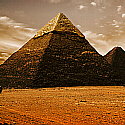Dead Sea Scrolls
 If someone had asked a minister in 1947 to prove that the original Hebrew Scriptures from the Old Testament were reliably copied without error throughout the last two thousand years, he might have had some difficulty in providing an answer. The oldest Old Testament manuscript used by the King James translators was dated approximately A.D. 1100. Obviously, that old manuscript from A.D. 1100 was a copy of a copy of a copy, etc. for over two thousand years.
If someone had asked a minister in 1947 to prove that the original Hebrew Scriptures from the Old Testament were reliably copied without error throughout the last two thousand years, he might have had some difficulty in providing an answer. The oldest Old Testament manuscript used by the King James translators was dated approximately A.D. 1100. Obviously, that old manuscript from A.D. 1100 was a copy of a copy of a copy, etc. for over two thousand years.
How could we be sure that the text in the A.D. 1100 copy of the Scriptures was identical with the original text as given to the writers by God and inspired by Him? However, an extraordinary discovery occurred in the turbulent year before Israel became a nation. A Bedouin Arab found a cave in Qumran near the Dead Sea which ultimately yielded over a thousand priceless manuscripts dating back before A.D. 68, when the Roman legions destroyed the Qumran village during the Jewish war against Rome.
An Arab shepherd boy discovered the greatest archeological finds in history in 1947. When the ancient Hebrew scrolls from these caves were examined by scholars they found that this Qumran site contained a library with hundreds of precious texts of both biblical and secular manuscripts that dated back before the destruction of the Second Temple and the death of Jesus Christ. Once the Bedouins recognized the value of the scrolls they began searching for additional documents in every valley and cave near the Dead Sea.
 The most incredible discovery was the immense library of biblical manuscripts in Cave Four at Qumran that contained every single book of the Old Testament with the exception of the Book of Esther.
The most incredible discovery was the immense library of biblical manuscripts in Cave Four at Qumran that contained every single book of the Old Testament with the exception of the Book of Esther.
Multiple copies of several biblical texts such as Genesis, Deuteronomy and Isaiah were found in Cave Four. Scholars were able to reach back a further two thousand years in time to examine biblical texts that had lain undisturbed in the desert caves during all of the intervening centuries. The scholars discovered that the Hebrew manuscript copies of the most authoritative Hebrew text, Textus Recepticus, used by the King James translators in 1611, were virtually identical to these ancient Dead Sea Scrolls.
After carefully comparing the manuscripts they discovered that, aside from a tiny number of spelling variations, not a single word was altered from the original scrolls in the caves from the much copied A.D. 1100 manuscripts used by the Authorized King James Version translators in 1611. How could the Bible have been copied so accurately and faithfully over the many centuries without human error entering into the text? The answer is found in the overwhelming respect and fear of God that motivated Jewish and Christian scholars whose job was to faithfully copy the text of the Bible.
The Essenes were a Jewish community of ascetics that lived primarily in three communities: Qumran at the Dead Sea, the Essene Quarter of Jerusalem (Mount Zion), and Damascus. They appear to have existed from approximately 200 B.C. until the destruction of their communities in Jerusalem and Qumran by the Roman armies in A.D. 68. During the first century there were three significant Jewish religious communities: the Pharisees, the Sadducees, and the Essenes.
The Essenes established their religious community near the shores of the Dead Sea. In their love for the Word of God they faithfully copied each Old Testament scroll in their Scriptorium in the village of Qumran. New evidence indicates that these men of God were aware of the new religious leader in Israel known as Jesus of Nazareth and the group of writings about Him known as the New Testament. The Christian historian Eusebius, who wrote around A.D. 300, believed that the Essenes were influenced in their beliefs by Christianity.
When the scrolls were first discovered, many Christian scholars naturally wondered if they might contain evidence about the new faith of Christianity. Despite overwhelming interest, the vast majority of scrolls were not translated for publication in the intervening forty-nine years.
For almost fifty years, the hopes of Christian scholars were frustrated by the decision of the small group of original scroll scholars to withhold publication and release of a significant number of these precious scrolls. Some scholars speculated publicly that there might be evidence about Christ in the unpublished scrolls but the original scroll scholars vehemently denied these claims. While some scroll scholars had published part of their assigned texts, after forty-five years the team responsible for the huge number of scrolls discovered in Cave Four had published only twenty percent of the five hundred Dead Sea Scrolls in their possession.
Quotes from the New Testament in the Dead Sea Scrolls
Finally, after a public relations campaign demanded the release of the unpublished scrolls to other scholars, the last of the unpublished scrolls were released to the academic world. To the great joy and surprise of many scholars, the scrolls contain definite references to the New Testament and, most importantly, to Jesus of Nazareth. In the last few years several significant scrolls were released that shed new light on the New Testament and the life of Jesus. One of the most extraordinary of these scrolls released in 1991 actually referred directly to the crucifixion of Jesus Christ.
The Crucified Messiah Scroll
In 1991 the world was astonished to hear that one of the unpublished scrolls included incredible references to a “Messiah” who suffered crucifixion for the sins of men. The scroll was translated by Dr. Robert Eisenman, Professor of Middle East Religions of California State University. He declared, “The text is of the most far-reaching significance because it shows that whatever group was responsible for these writings was operating in the same general scriptural and Messianic framework of early Christianity.” Although the original scroll team still claimed that there was no evidence about early Christianity in the unpublished scrolls, this new scroll totally contradicted their statements.
This single scroll is earth-shaking in its importance. As Dr. Norman Golb, Professor of Jewish History at the University of Chicago said, “It shows that contrary to what some of the editors said, there are lots of surprises in the scrolls, and this is one of them.”
This remarkable five-line scroll contained fascinating information about the death of the Messiah. It referred to “the Prophet Isaiah” and his Messianic prophecy (Chapter 53) that identified the Messiah as one who will suffer for the sins of his people. This scroll provides an amazing parallel to the New Testament revelation that the Messiah would first suffer death before He would ultimately return to rule the nations. Many scholars believed that the Jews during the first century of our era believed that, when he finally came, the Messiah would rule forever without dying.
The exciting discovery of this scroll reveals that the Essene writer of this scroll understood the dual role of the Messiah as Christians did. This scroll identified the Messiah as the “Shoot of Jesse” (King David’s father) the “Branch of David,” and declared that he was “pierced” and “wounded.” The word “pierced” remind us of the Messianic prophecy in Psalms 22:16: “They pierced my hands and feet.” The prophet Jeremiah (23:5) said, “I will raise unto David a righteous branch.”
The scroll also describes the Messiah as a “leader of the community” who was “put to death.” This reference pointing clearly to the historical Jesus of Nazareth is creating shock waves for liberal scholarship that previously assumed that the Gospel account about Jesus was a myth. Jesus is the only one who ever claimed to be the Messiah who was crucified. The genealogies recorded in both Matthew and Luke’s Gospels, reveal that Jesus was the only one who could prove by the genealogical records kept in the Temple that He was the lineage of King David as the “Son of Jesse.” Since the tragic destruction of the Temple and its records in A.D. 70 it would be impossible for anyone else to ever prove their claim to be the Messiah based on their genealogical descent from King David. Additionally, the scroll identified the Messiah as “the sceptre” which probably refers to the Genesis 49:10 prophecy, “The sceptre shall not depart from Judah, nor a lawgiver from between his feet, until Shiloh come; and unto him shall the gathering of the people be.” This scroll confirms the historical truthfulness of the New Testament record about Jesus and His crucifixion. The evidence from the scroll suggests that the Jewish Essene writer acknowledged that Jesus of Nazareth was the “suffering Messiah” who died for the sins of His people.
The “Son of God” Scroll
Another fascinating scroll discovered in Cave Four known as 4Q246 refers to the hope of a future Messiah figure. This is another of the scrolls that was unpublished until recently. Amazingly, the text in this scroll refers to the Messiah as “the son of God” and the “son of the Most High.” These words are the exact wording recorded in the Gospel of Luke.
The Text of Scroll 4Q246 – the Son of God Scroll:
“He shall be called the son of God, and they shall designate [call] him son of the Most High. Like the appearance of comets, so shall be their kingdom. For brief years they shall reign over the earth and shall trample on all; one people shall trample on another and one province on another until the people of God shall rise and all shall rest from the sword.”
Compare the words in the scroll 4Q246 text to the inspired words found in Luke 1:32 and 35: “He shall be great, and shall be called the Son of the Highest: and the Lord God shall give unto him the throne of his father David… And the angel answered and said unto her, The Holy Ghost shall come upon thee, and the power of the Highest shall overshadow thee: therefore also that holy thing which shall be born of thee shall be called the Son of God” (Luke 1:32-35).
Anyone comparing these two first century texts will be startled by the amazing similarity of concept and wording describing the Messianic leader. One of the great differences between Christian and Jewish conceptions of the promised Messiah revolves around His relationship to God. While the Jews believe the Messiah will be a great man, such as Moses, with a Divine mission, the Christians believe that the Bible teaches that the Messiah would be uniquely “the Son of God.” The Jewish view usually held that the concept of a “son of God” violated the primary truth of monotheism found in Deuteronomy 6:4
“Hear, O Israel: The Lord our God is one Lord.”
The Christians believed that Jesus’ claim to be the Son of God was not a violation of Deuteronomy 6:4. Rather, Christians believe in the Trinity, the doctrine that the Father, the Son and the Holy Spirit are revealed in the Bible to be One God, revealed in three personalities.
As Christians, we do not believe in three separate gods. Therefore, Christians understand the statements about Jesus as the Son of God to be in complete conformity to the truth of monotheism – there is only one God. It is fascinating in this regard to consider the presence of these statements in this first century Jewish text: “He shall be called the son of God, and they shall designate [call] him son of the Most High.”
The presence of these statements in the Dead Sea Scrolls suggests that some of the Essenes either accepted the Messianic claims of Jesus to be the Son of God or anticipated this concept. Either possibility opens up new areas for exploration. Another possibility that must be considered is this: Is it possible that this scroll 4Q246 is a direct quote from the writer hearing the words of the Gospel of Luke that was now widely circulating according to early Christian witnesses? Luke, the physician, claimed that he wrote the Gospel of Luke as an eyewitness of the events he personally observed. In Luke 1:1-3, he says:
“Forasmuch as many have taken in hand to set forth in order a declaration of those things which are most surely believed among us, Even as they delivered them unto us, which from the beginning were eyewitnesses, and ministers of the word; It seemed good to me also, having had perfect understanding of all things from the very first, to write unto thee in order, most excellent Theophilus.”
The discovery of the virtually identical wording “the Son of God” from Luke 1:32 and 35 with the scroll found buried in a cave in A.D. 68 stands as a tremendous witness to the early existence and transmission of the Gospel records within thirty-five years of Christ. If the Gospels were written and distributed within thirty-five years of the events of the life of Jesus (as the Gospels claim) then they stand as the best eyewitness historical records we could ever hope to possess. It would be almost impossible to distribute the Gospel accounts to thousands of people in Israel within three and a half decades of the events unless they were true accounts. If the Gospel records were untrue, many witnesses would have stood up and denied their accuracy. However, the records of the first century reveal that no one denied the facts about the life, death, and resurrection of Jesus. In fact, all of these ancient historical records confirm the truth of the Gospels.
Other New Testament Quotes Identified in the Scrolls
In 1971, a Spanish biblical scholar named Jose O’Callaghan studied some of the small fragments of scrolls discovered in Cave Seven at Qumran. He was looking for correspondences between these fragments of Greek scrolls and the Septuagint, the Greek translation of the Hebrew Old Testament that was widely used by Jesus and the apostles.
These fragments are quite small containing only small portions of each verse. After almost two thousand years, the elements and insects have significantly damaged these manuscripts. In some cases only small fragments containing parts of a verse on three or four lines remain from an original scroll. It required considerable detective work to determine the precise text in these tiny fragments.
One day he carefully examined several small scroll fragments located in a photo page in The Discoveries of the Judean Desert of Jordan. To his great surprise O’Callaghan noticed that several did not fit any Old Testament text. These fragments were listed as “Fragments not identified.” To his amazement Dr. O’Callaghan found that these Greek language fragments bore an uncanny resemblance to several verses in the New Testament. He read the Greek words “beget” and a word that could be “Gennesaret,” a word for the Sea of Galilee. The fragment containing “Gennesaret” appears to be a quotation of the passage referring to the feeding of the five thousand found in Mark 6:52,53 which states: “For they considered not the miracle of the loaves: for their heart was hardened. And when they had passed over, they came into the land of Gennesaret, and drew to the shore.”
If these texts are actually portions of these Christian writings they would be the earliest New Testament texts ever discovered. The New York Times responded, “If O’Callaghan’s theory is accepted, it would prove that at least one of the Gospels, that of St. Mark, was written only a few years after the death of Jesus.” The Los Angeles Times headlined, “Nine New Testament fragments dated A.D. 50 to A.D. 100 have been discovered in a Dead Sea Cave.” It stated that “if validated, [they] constitute the most sensational biblical trove uncovered in recent times.”
Other Scroll Fragments and the New Testament
Dr. Jose O’Callaghan ultimately identified eight different scroll fragments from Cave Seven that appear to be quotes from New Testament passages. The scholarly magazine Bible Review ran a fascinating article on Dr. O’Callaghan, these scrolls, and their possible connection with the New Testament in an article in December, 1995.
The fragments appeared to O’Callaghan to be portions of the following verses from the Gospels and Paul’s Epistles:
“For the earth bringeth forth fruit of herself” (Mark 4:28). “And he saw them toiling in rowing” (Mark 6:48).
“And Jesus answering said unto them, Render to Caesar” (Mark 12:17)
“when they had eaten enough, they lightened the ship” (Acts 27:38). “we also joy in God through our Lord Jesus Christ.” (Romans 5:11-12). “without controversy great is the mystery of godliness” (1 Tim 3:16). “For if any be a hearer of the word, and not a doer” (James 1:23-24).
As one example of Dr. O’Callaghan’s study, he examined a small scroll fragment known as 7Q5 that contained only twenty Greek letters on five lines of text. Many of the thousands of scroll fragments that were successfully identified from the Qumran site are equally small. Another scroll scholar, Carsten Thiede, agrees with O’Callaghan that portions of the Mark 6:52,53 passage appears in this scroll fragment. While other scroll scholars disagree with the identification of this fragment as a verse from the New Testament they do admit that almost all of the scrolls found in Cave Seven were written in the period between 50 BC and AD 50, which is consistent with the time of the writing of the Gospel of Mark.
The new archeological exploration of recently detected caves at Qumran will provide new evidence of New Testament references. Many of these mysteries will be solved when the final four hundred unpublished scrolls are finally published in the next few years. The new dig at Qumran may also uncover additional scrolls that will help us understand more clearly the Messianic beliefs of this group of religious men and women who lived at this desert site during the time when Jesus walked the earth.
When we consider the total amount of evidence that confirms the biblical record about Jesus of Nazareth we can have confidence that we know more about the life and resurrection of Christ than we know about any other person in the ancient world. God has not left us in darkness concerning the truthfulness of the miracles, prophecies and teaching of His Son, Jesus Christ!





